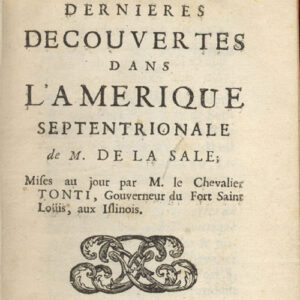calsfoundation@cals.org
René-Robert Cavelier, Sieur de La Salle (1643–1687)
In 1682, French explorer René-Robert Cavelier, Sieur de La Salle journeyed down the Mississippi River in search of a water route to the Gulf of Mexico. Stopping in present-day Arkansas County at the current site of Arkansas Post National Memorial, La Salle erected a cross to designate the region “Louisiana” in honor of Louis XIV, king of France. He was one of the first European explorers to make alliances with the Native Americans of Arkansas and the first to try to establish a permanent settlement in Arkansas through his friend and fellow explorer, Henri de Tonti.
La Salle was born in Rouen, France, on November 21, 1643. His parents, Catherine Gesset and Jean Cavlier, were wealthy merchants. Educated at the Jesuit College in Rouen, La Salle gave up his inheritance to enter the Society of Jesus and studied to become a priest. Feeling unsuited for the priesthood, La Salle left the order and sailed for Canada in 1667 to join his brother, Jean. He traded furs in the Ohio River valley and explored the Mississippi River Valley with the objective of establishing fur trading posts from the Great Lakes to the Gulf of Mexico.
By the 1670s, La Salle secured a patent of nobility and a seigniorial grant from the French king for land in North America. Aided by de Tonti, La Salle cultivated important military, social, and political alliances with Indian tribes in the Mississippi River Valley. Reaching Arkansas in 1682, La Salle and his men stopped at the Quapaw village of Kappa, a settlement located on the Mississippi River approximately twenty miles south of the mouth of the White River, where, after initial suspicion, the tribe received them cordially. Before leaving the Quapaw, La Salle erected a column bearing the coat of arms of Louis XIV and a painted cross at Kappa. From this moment until Spanish domination of Louisiana in the 1760s, the Quapaw allied themselves with the French to obtain firearms and manpower to face their enemies; they also traded, formed political alliances, and even intermarried with them. It was an advantageous relationship for both the Quapaw and the French. Following this ceremony, La Salle made a land grant to his trusted friend, de Tonti, who established a small trading post that would become Arkansas’s first permanent European settlement, Arkansas Post (Arkansas County), in 1686.
La Salle returned to France in order to promote settlement in French-occupied territory. Returning to North America with 200 colonists, La Salle’s expedition missed the mouth of the Mississippi River and ended up landing on the coast of Matagorda Bay, Texas, in 1685. He ordered a fort to be built and set off in search of the Mississippi River with several colonists. His error in judgment and indecision regarding their situation caused dissention, which led members of the exploration party to kill him on March 19, 1687, near the Hasinai (Tejani Indians) village.
La Salle ultimately failed in his undertaking of establishing fur trading posts along the Mississippi River, but his expeditions were his fame. However, he did open the great waterway for development and established friendships with Arkansas Indians, who would assist and support the French colonial settlers in the area for over 100 years.
For additional information:
Arnold, Morris. Colonial Arkansas, 1686–1804: A Social and Cultural History. Fayetteville: University of Arkansas Press, 1991.
———. Rumble of a Distant Drum: The Quapaw and Old World Newcomers, 1673–1804. Fayetteville: University of Arkansas Press, 2000.
————. Unequal Laws Unto a Savage Race: European Legal Traditions in Arkansas, 1686–1836. Fayetteville: University of Arkansas Press, 1985.
Chesnal, Paul. History of Cavelier de la Salle, 1643–1687. Translated by Andree Chesnel Meany. New York: Putnam, 1932.
Cox, Isaac Joslin, ed. The Journeys of Rene Robert Cavelier, Sieur de la Salle. New York: Barnes, 1905.
Parkman, Francis. La Salle and the Discovery of the Great West. New York: New American Library, 1963.
Weddle, Robert S., ed. La Salle, the Mississippi, and the Gulf: Three Primary Documents. College Station: Texas A&M University Press, 1987.
Lea Flowers Baker
Little Rock Central High School National Historic Site
 Henri de Tonti's Account of La Salle's Voyages
Henri de Tonti's Account of La Salle's Voyages  René-Robert Cavelier, Sieur de La Salle
René-Robert Cavelier, Sieur de La Salle 




Comments
No comments on this entry yet.